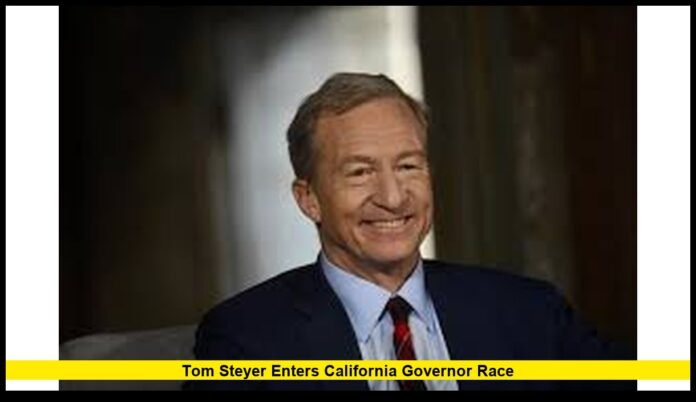Tom Steyer announced his candidacy for governor of California, adding his name to the 2026 race in a major shake-up for the state’s political landscape. The billionaire investor and long-time Democratic donor declared his run on November 19, 2025, positioning himself around affordability and corporate accountability as key campaign themes.
Why His Entry Matters
Steyer’s entry into the race brings weight because of his financial resources, his activism background, and the timing. With the current governor’s term ending, California’s next election opens a rare window. Steyer frames his campaign as focused on the everyday cost pressures Californians face, signaling his intent to tackle living costs, housing, utilities and corporate influence.
His announcement video underscored the message: “The Californians who make this state run are being run over by the cost of living,” he said. He pledged a “back to basics” approach, promising to make corporations pay their fair share.
In doing so, he moves beyond his previous public-campaign profile into full electoral mode. Given his name recognition and ability to self-fund, his candidacy shifts the dynamics for other contenders.
Key Campaign Themes
Affordability and Cost of Living
At the heart of his campaign is the cost of living crisis. He emphasizes:
- Lowering utility rates
- Expanding housing supply
- Making preschool and community college tuition-free
- Reducing household bills tied to monopolistic corporate practices
This shift toward economy and consumer-cost issues may help him appeal beyond traditional progressive voters who focus primarily on climate or social justice.
Corporate Power and Accountability
Another prominent strand of his message: the influence of large corporations. He aims to challenge entrenched business interests, suggesting that the state needs to make corporations pay their share of tax burden and responsibility. This resonates with voters frustrated by inequality and opaque corporate practices.
Leadership Without Government Experience
Steyer does not have elected office experience. His background includes hedge-fund leadership, activism and major political donations. For voters, this creates a blend of strengths and questions:
- Strength: He brings independence from career politics and deep financial resources.
- Question: He must show he can govern at scale in public office.
The Field and Competitive Landscape
The race is already crowded. Several prominent Democrats have declared or are expected to run, including former Los Angeles mayor Antonio Villaraigosa, ex-U.S. Representative Katie Porter, former Health and Human Services secretary Xavier Becerra, and others. On the Republican side, challengers are also emerging.
Given California’s “top-two” primary system where all candidates run on the same ballot and the top two advance regardless of party, internal Democratic competition is especially intense. Steyer enters as a major financial contender, but he will need to win voter trust, especially in a field full of experienced political figures.
Early Strategic Signals and Campaign Setup
Several early indicators point to how the campaign will operate:
- He released a high-production announcement video emphasizing registering cost burdens, everyday life pressures, and housing concerns.
- He frames his wealth as a tool for public service, rather than a liability. He claims his financial independence allows him to serve without corporate compromise.
- His message emphasizes economic issues over ideological debates—potentially a strategic pivot to appeal across demographics.
- His timeline suggests early investment in advertising and organization. Observers note a large-scale ad buy in California that indicated serious preparation.
Strengths and Potential Vulnerabilities
Strengths to Leverage:
- Financial firepower enabling early campaign traction and advertising reach.
- National name recognition from past political work and donations.
- A message centered on issues many Californians cite as important: housing, utilities, cost of living.
- A self-funded campaign model offering flexibility and independence.
Challenges to Overcome:
- The absence of prior elected office experience may lead voters to question his readiness to govern.
- His hedge-fund background may open criticism about wealth, privilege and corporate ties.
- Standing out in a deep field of competitors who may already have established political networks.
- Translating celebrity and self-funding into actual votes and grassroots support remains an operational hurdle.
What to Watch in the Coming Months
Several metrics will show how his campaign is progressing:
- Fundraising and Spending: How much he allocates personally vs. raising outside funds, and how that compares to rivals.
- Advertising and Media Saturation: Early ad buys and media presence across the state will indicate readiness.
- Polling Trajectory: Voter response to his candidacy, especially among independent and moderate voters, will matter.
- Endorsements and Organizational Strength: Who supports him—unions, local leaders, advocacy groups—will signal how broad his appeal is.
- Policy Roll-out: Detailed proposals will differentiate him from others; initial focus is on affordability, but more comprehensive platforms are expected.
- Debates and Public Scrutiny: With no prior public office experience, his performance in debates and public forums will shape perception of competence and leadership.
Implications for California’s Political Landscape
Steyer’s campaign changes several elements of the race:
- It adds a major financial competitor who can saturate campaign communications early.
- It forces other candidates to sharpen their message around affordability and cost of living.
- It raises questions about how wealth and politics intersect—in a state where economic inequality, housing shortage and corporate influence are central issues.
- It signals that the 2026 election could become a test of whether outsider wealth plus message can overcome traditional political organization and experience.
For Californians worried about housing, utility costs and everyday expenses, Steyer’s candidacy may appear promising. But for voters who prioritize governance experience and proven track records, the forthcoming months will test whether he can convincingly shift from donor and activist to candidate and leader.
Bottom Line
Tom Steyer’s entry into the California governor contest marks a significant moment. His blend of financial muscle, issue-driven message and outsider status makes him a contender worth watching. His path forward will require converting resources into trust, policy into results, and recognition into votes.
Have strong thoughts on how his campaign might influence California’s future? Share your view below and keep checking back for updates.
